Joseph Rosenbaum was “stating to Kyle and to Ryan Balch in each other’s presence, ‘If I get either of you two alone, I’m going to kill you”. – Defense attorney Mark Richards during opening statements
The prosecution’s presentation on the second day of the Kyle Rittenhouse trial in Kenosha, Wisconsin, was a train wreck. You wouldn’t know it from the rest of the media, of course, which focused on Rittenhouse yawning or other irrelevancies. How bad was it for the state? So bad that the prosecutor’s opening statement almost made the case for the defense.
Assistant District Attorney Thomas Binger, given the unenviable prosecution assignment, made no persuasive argument to counter Rittenhouse’s self-defense claims.
Come to think of it, why isn’t Kenosha County DA Mike Graveley handling what is arguably the biggest trial in Kenosha’s history? Because it’s got “loser” all over it, and always has, which begs the question of why the case was charged in the first place and why it was charged this way (Rittenhouse was charged with first-degree INTENTIONAL homicide in the death of Anthony Huber, who was smacking him with a skateboard, rushing him, and trying to grab his gun). If anything, the prosecution seemed to be making a strong case for only the misdemeanor firearm charge, which could result in a conviction, but they’ve done nothing whatsoever to advance the case for murder.
If the case was overcharged to appease rioters or a political party, it’s almost prosecutorial misconduct.
The defense, in contrast, presented a very strong case for self-defense.
The prosecution’s chances of convicting Rittenhouse on homicide charges always rested on whether they had something new that the public wasn’t privy to. They did; but that new evidence – a grainy infrared photo from a secretive FBI spy plane – crumbled spectacularly, at least for now. In fact, the most compelling new piece of evidence came from the defense: an alleged threat to kill Rittenhouse from the first man he shot, Joseph Rosenbaum – a threat witnessed by a third party, although that third party has a problematic background.
Kyle Rittenhouse Trial Day 2:
Here were the big moments that emerged from day 2 and the opening statements:
Joseph Rosenbaum’s alleged threat to kill
To prove that Rittenhouse was legally justified in using self-defense, the defense must show that he reasonably believed that he, or others, were in imminent danger of death or great bodily harm when he shot Joseph Rosenbaum, Anthony Huber, and Gaige Grosskreutz, on Aug. 25, 2020, after nights of rioting and arson fires.
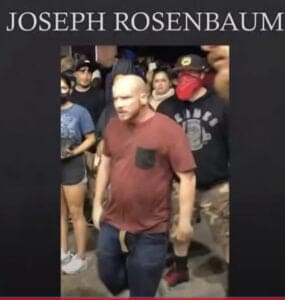 We already knew, from video and witnesses, that Rosenbaum, a convicted child molester out on bail for domestic violence battery (the jury won’t learn those details), was chasing Rittenhouse into the corner of a car lot parking lot, threw a hospital bag at him, and was reaching for his gun when Rittenhouse shot him. It’s hard to see how that’s not self-defense, and you can see a lot of it on video.
We already knew, from video and witnesses, that Rosenbaum, a convicted child molester out on bail for domestic violence battery (the jury won’t learn those details), was chasing Rittenhouse into the corner of a car lot parking lot, threw a hospital bag at him, and was reaching for his gun when Rittenhouse shot him. It’s hard to see how that’s not self-defense, and you can see a lot of it on video.
Defense attorney Mark Richards revealed during opening statements that Joseph Rosenbaum was “stating to Kyle and to Ryan Balch in each other’s presence, ‘If I get either of you two alone, I’m going to kill you. Flat out threats to murder.'” That’s a new claim.
That’s a very strong piece of evidence for self-defense, although Balch is surely to be controversial (he’s an Army veteran who has posted Nazi propaganda, according to the Chicago Sun-Times.) It should be noted that Balch, who is allegedly associated with the disturbing boogaloo-boi movement, said that Rittenhouse had no tie to it; no evidence has emerged of Rittenhouse being tied to militia or white supremacist groups before the shootings, and his lawyers previously revealed in court that a detailed analysis of his cell phone revealed as much. Rather, he randomly met up with people he didn’t know who came to Kenosha because they also said they wanted to protect businesses.
But the prosecution offered no counter-argument for a conversation (or argument) Binger said occurred between Rosenbaum and Rittenhouse. He said that no one knows what they said. But, of course, Rittenhouse can tell his account to the jury.
Furthermore, the journalist who was behind Rosenbaum, Richie McGinniss, revealed that Rosenbaum let loose “one of the scariest screams I ever heard, yelling ‘f*** you,” and dove for Kyle Rittenhouse’s gun,” right before he was shot, according to the Richards. That’s another new detail. Even accounting for Balch’s credibility problems, there are so many puzzle pieces that portray Rosenbaum as a threat that day, and day 1 just added more of them.
Since self-defense in the Rosenbaum shooting revolves around whether Rittenhouse reasonably believed that Rosenbaum, who had camouflaged his identity by wrapping his T-shirt around his head, was an imminent threat to him of great bodily harm or death, this alleged threat seems very relevant. But most of the media stories ignored or buried it.
Rittenhouse is likely to testify
Defense attorney Richards told jurors they would hear from Rittenhouse at one point. Since it’s his state of mind at issue, that seems inevitable. How the perhaps immature 18-year-old would fair under cross-examination remains a wildcard in the case.
The weird FBI spy plane video issue
The prosecution made a big deal out of an FBI spy-type plane video that captured figures in infrared during the shooting from up high.
In opening statements, Binger even claimed that Rittenhouse was the person who chased Rosenbaum first before Rosenbaum started chasing Rittenhouse, leading to the shooting. This sounds significant because it’s an attempt to paint Rittenhouse as an aggressor, which could weaken a self-defense argument and was previously unknown. The only thing known before day 1 of the trial was that Rosenbaum is seen on video CHASING RITTENHOUSE.
Except…
First of all, Binger’s infrared Rittenhouse-was-chasing-first argument seemed weak. What matters in determining self-defense is what Rittenhouse’s state of mind was when he opened fire, not minutes before he was chased down by Rosenbaum, who tried to grab his gun.
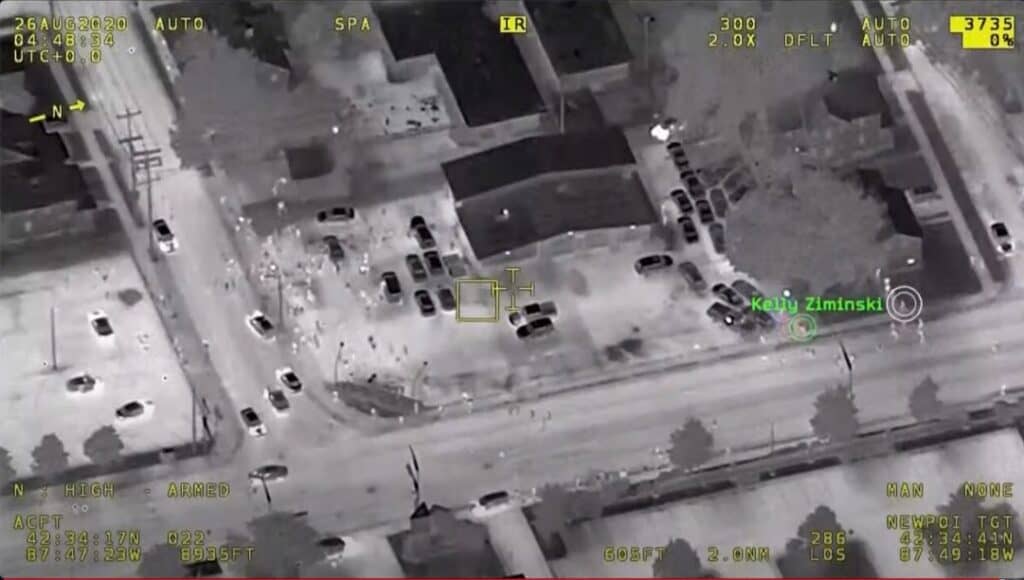 But… bizarrely… when the prosecutor called FBI agent Brandon Cramin to the stand, the agent’s testimony was cut off before anyone even established who the infrared figures were in the video. This is apparently so top secret that the judge cut off the audio and video to the FBI agent’s testimony. However, a pool report from a journalist in the courtroom gave the following bizarre account (in the pool reporter’s words):
But… bizarrely… when the prosecutor called FBI agent Brandon Cramin to the stand, the agent’s testimony was cut off before anyone even established who the infrared figures were in the video. This is apparently so top secret that the judge cut off the audio and video to the FBI agent’s testimony. However, a pool report from a journalist in the courtroom gave the following bizarre account (in the pool reporter’s words):
Prosecutors said they were done questioning the FBI agent before they ever identified anyone in the grainy footage or explaining the significance of it to the Rittenhouse case. They will likely circle back to the video later in the presentation.
The defense then began cross-examination. During cross-examination, when the defense asked for the tail number of the two-man plane, prosecutors objected. The judge then asked the attorneys to step forward for a sidebar on the issue.
The judge then asked jurors to leave the courtroom as they continued to discuss the video taken by the FBI agent in the surveillance plane. Defense lawyer Mark Richards told the judge he believes there was other video taken by the FBI that’s no longer available.
Richards said he was incredulous that the FBI could take video that captured alleged homicides and then got rid of that video.
“That is preposterous,” Richards added. The judge balked when prosecutor Binger told him regarding footage from the plane that “the federal government is not under our control.”
“I beg your pardon,” the judge said, interrupting Binger.
“I don’t get this,” the judge said. “This is a criminal prosecution … if there is going to be cloak and dagger stuff. What’s going on?”
He later said prosecutors should skip the FBI agent for now, call a different witness, and come back to the issue of the plane later.
It’s all bizarre, but it should be mentioned again that Binger made a big deal in opening statements about Rittenhouse supposedly chasing Rosenbaum first (he also said Rosenbaum was “very easy to see in the video,” and then didn’t back it up.
Other weak prosecution arguments
Binger also tried to repeatedly convince the jury that it was somehow relevant that Rittenhouse was the only person who shot and killed anyone in Kenosha.
What he left out and the defense swiftly reminded the jury: Only Rittenhouse was chased by Joseph Rosenbaum.
At any rate, just because you’re the only person who had to use self-defense during a situation doesn’t nullify the legal right to exercise it. It’s really a ridiculous argument.
Binger also made a big deal of the fact that the fourth shot that killed Rosenbaum hit him in the back. But the first shots didn’t; Rosenbaum was chasing Rittenhouse. What matters is whether Rittenhouse reasonably believed he was in danger when he started to fire, not how Rosenbaum was wounded as he fell.
He tried to make a big deal out of Rittenhouse not rendering aid to Rosenbaum, but that’s irrelevant to the self defense argument and, at any rate, other people were rendering aid.
Binger did not dispute key defense points.
In fact, Binger said in his opening statement that Rosenbaum was “running after the defendant.” Binger called it a “foot pursuit.” He said Rosenbaum “closes on the defendant.”
Rosenbaum was armed with a chain that night
We broke this story months ago. The defense wove it into opening statements and also revealed that Rosenbaum was seen lighting arson fires that night (a trailer) and a dumpster.
“He arms himself with a chain and goes up and down Sheridan Road, carrying this rather heavy chain,” Richards, the defense attorney, said of Rosenbaum. He said Rosenbaum “lit the fuse that night.”
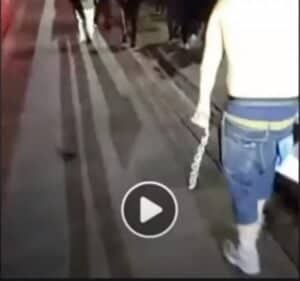 He also played a video snippet for the jury of Rosenbaum using a racial slur and getting agitated in a gas station parking lot, telling people to shoot him. That was previously reported also.
He also played a video snippet for the jury of Rosenbaum using a racial slur and getting agitated in a gas station parking lot, telling people to shoot him. That was previously reported also.
The bottom line: We already knew Rosenbaum was an unsavory character, but his actions that night, including new details revealed by the defense, paint him thoroughly as an aggressor. In contrast, the prosecution did nothing to show Rittenhouse doing anything aggressive or violent before the shootings. He was cleaning up graffiti, acting as a medic, carrying a fire extinguisher, and offering to protect a business whose other location burned to the ground. The prosecutor didn’t dispute these things, but he did try to argue that people are more important than property. That’s true, but it also doesn’t nullify a person’s right to self-defense when confronted by an aggressive attacker.
The notion of Rittenhouse as a member of an organized, armed militia evaporated completely
Channel 12 falsely described the testimony of Rittenhouse’s friend, Dominick Black, saying he described Rittenhouse as being part of an armed militia. That’s false. What Black testified and what opening statements revealed was that Rittenhouse had ties to Kenosha (his dad lived there, and he worked in the area as a lifeguard). He was hanging out with a long-time Kenosha friend that day, Black.
They then went to try to protect businesses and help out, and eventually, they randomly ran across other people they didn’t know who had come to Kenosha for the same reason. That’s it.
In contrast, new video shows rioters were destroying vehicles at the gas station as Rittenhouse ran toward it, giving him no clear line of escape from Rosenbaum. Furthermore, another man fired a gun in the air right before Rittenhouse fired (we previously wrote about that man, Joshua Ziminski.)
Grosskreutz wasn’t honest with the police, the defense alleged
The defense attorney said Grosskreutz told police he lost his gun prior to confronting Rittenhouse; however, video and photos show he did have a gun when he confronted Rittenhouse. “He had a gun in his hand,” Richards said. He also told them that he was trying to stop Huber “from beating Kyle” with the skateboard. So was Grosskreutz, the People’s Revolution poster boy with a past prowling accusation, making the case FOR Rittenhouse on self-defense? Interesting.
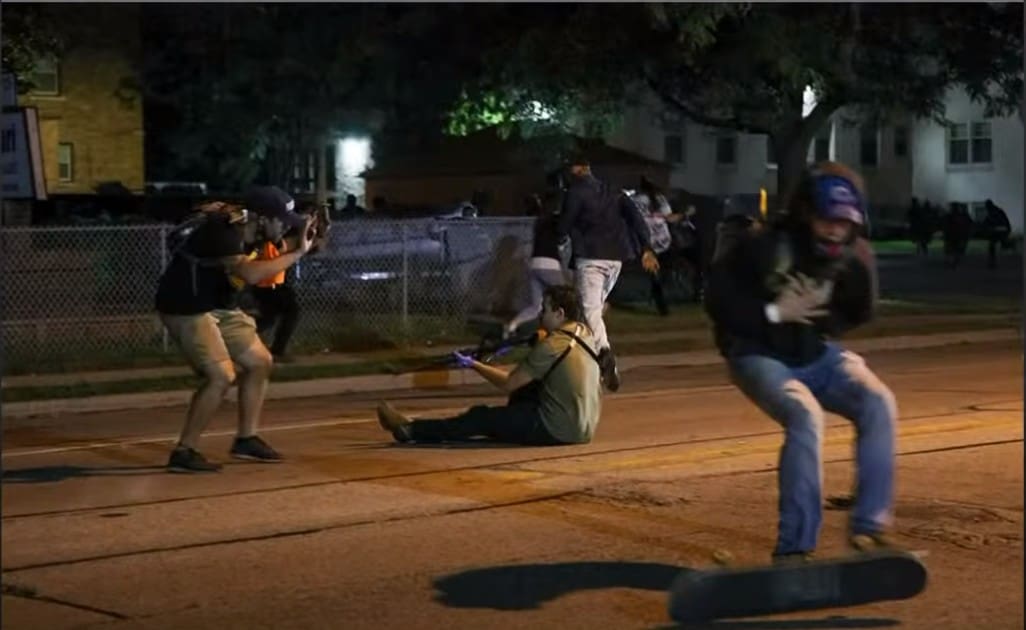 More critically, even the prosecution admits Grosskreutz was moving toward Rittenhouse when shot and was armed. The prosecution really tried to make no argument for why this shooting was not self-defense. Furthermore, video showed that Grosskreutz approached Rittenhouse another time. That’s new.
More critically, even the prosecution admits Grosskreutz was moving toward Rittenhouse when shot and was armed. The prosecution really tried to make no argument for why this shooting was not self-defense. Furthermore, video showed that Grosskreutz approached Rittenhouse another time. That’s new.
Huber touched Rittenhouse’s gun
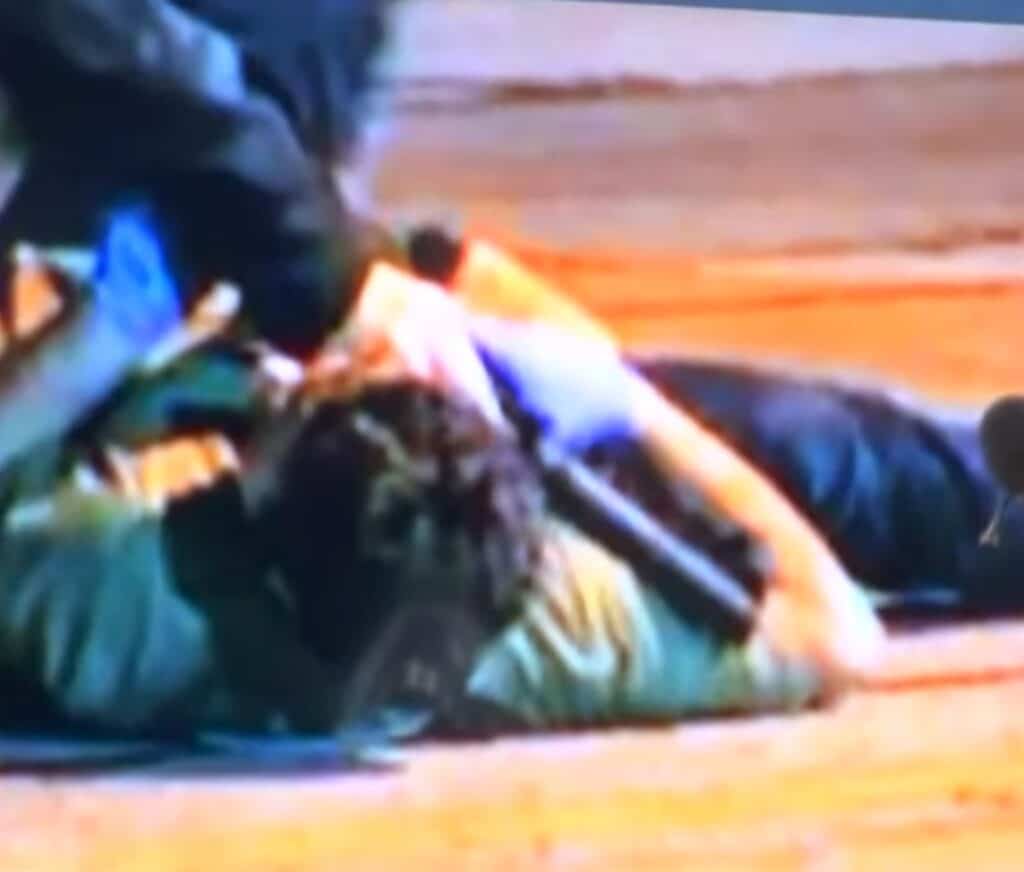
Photos show that Huber got a hand on Rittenhouse’s gun. The defense is building a strong case that Huber (and Rosenbaum) were trying to disarm Rittenhouse. While it’s widely known that Huber struck Rittenhouse with a skateboard, it wasn’t as clear before that he actually had a hand on Rittenhouse’s gun, which Richards proved through photographic evidence on day 2.
Rittenhouse was struck by others
How in peril was Rittenhouse? We learned new information about that. The defense said Rittenhouse was hit by a man’s hand or who had a rock in his hand; he eventually fell to the ground. “These individuals are running up on him,” Richards said. He was then kicked “square in the face” by a man still not identified who is being called “jump kick man.” A second, if that, later, Huber rushed Rittenhouse while Rittenhouse had fallen to the ground and was shot. He was in a very vulnerable position, yet still was able to discern between threats and non-threats (not shooting another man who backed off).
People were shouting things like “beat him up” and “get his ass” right before Rittenhouse shot Huber and Grosskreutz
This is also according to the criminal complaint: People were shouting what sounded like “beat him up” and “Hey, he shot him” and “Get him! Get that dude.” Another man had run toward Rittenhouse, swung at him, and made contact – he knocked his hat off. “Get his ass!” someone shouted.
Self-defense laws
For months, the prosecution bent over backward to get incendiary nonsense in front of the Kyle Rittenhouse jury (he posed with some Proud Boys months AFTER the shootings; the donors to his defense fund should be unmasked, etc.) There’s an obvious reason they’re doing this. The Rittenhouse prosecution was flawed from the start.
Their only hope was to cloud the jury with irrelevant nonsense, but non-nonsense Judge Bruce Schroeder wasn’t having it for months, the media have been invested in the politically biased narrative that the teenage Rittenhouse is a Trump and police-loving, MAGA-style caricature. Never have the media seemed less interested in exploring the presumption of innocence, due process, or the excesses of the court system.
The statute. Self-defense: “The actor may not intentionally use force which is intended or likely to cause death or great bodily harm unless the actor reasonably believes that such force is necessary to prevent imminent death or great bodily harm to himself or herself.”
According to the Milwaukee Journal Sentinel, Rittenhouse “need only make ‘some showing’ of self-defense.” If he does, prosecutors have the burden to show beyond a reasonable doubt that his belief “was either dishonest or unreasonable.” The newspaper noted that in the Anthony Huber death, in which he’s charged with first-degree INTENTIONAL homicide, there’s also the possibility of an imperfect self-defense finding, meaning it was honest but unreasonable. This would reduce that charge to second-degree. A finding of reasonableness would result in acquittal. Jury instructions say, The law of self-defense allows the defendant to threaten or intentionally use force against another only if:
• the defendant believed that there was an actual or imminent unlawful interference1
with the defendant’s person; and
• the defendant believed that the amount of force the defendant used or threatened to
use was necessary to prevent or terminate the interference; and
• the defendant’s beliefs were reasonable.
“A belief may be reasonable even though mistaken. In determining whether the defendant’s beliefs were reasonable, the standard is what a person of ordinary intelligence and prudence would have believed in the defendant’s position under the circumstances that existed at the time of the alleged offense. The reasonableness of the defendant’s beliefs must be determined from the standpoint of the defendant at the time of the defendant’s acts and not from the viewpoint of the jury now.”
The jury instructions also say: “A person who engages in unlawful conduct of a type likely to provoke others to attack, and who does provoke an attack, is not allowed to use or threaten force in self-defense against that attack.””So, in Wisconsin, if you provoke an attack, you cannot then claim self-defense unless you truly feel your life is in danger. And even then, you must make every effort to escape the situation and give notice to the other actors that you are abandoning the fight,” Birdsall Law wrote in an analysis of this issue.
However, in addition to running away from Rosenbaum, video also showed Rittenhouse running toward police and trying to surrender with his hands up.
The Kyle Rittenhouse Trial Day 1 can be seen here:
Table of Contents
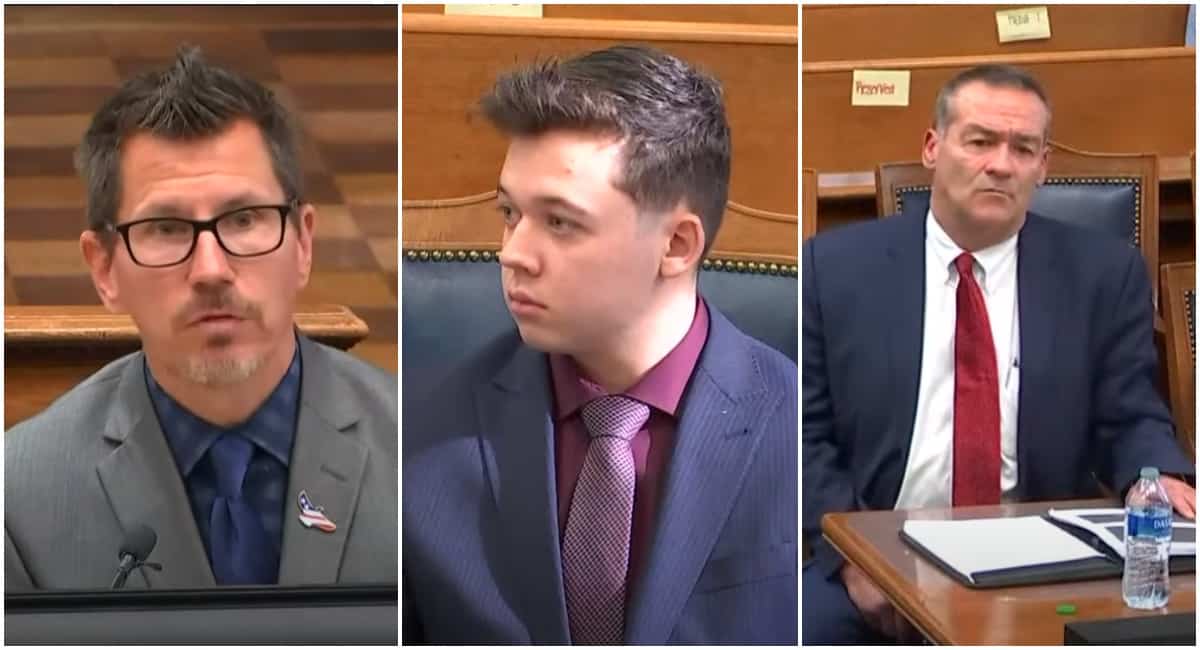

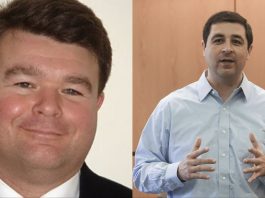
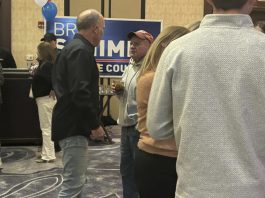

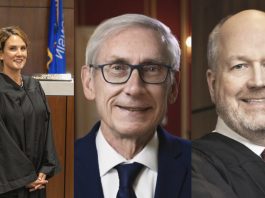


![WATCH: Elon Musk Town Hall Rally in Green Bay [FULL Video]](https://www.wisconsinrightnow.com/wp-content/uploads/2022/04/Elon_Musk_3018710552-265x198.jpg)

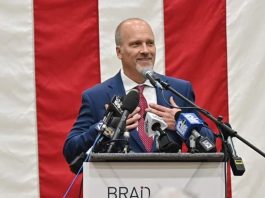

![The Great American Company [Up Against the Wall]](https://www.wisconsinrightnow.com/wp-content/uploads/2025/03/MixCollage-29-Mar-2025-09-08-PM-4504-265x198.jpg)
![The Wisconsin DOJ’s ‘Unlawful’ Lawman [WRN Voices] josh kaul](https://www.wisconsinrightnow.com/wp-content/uploads/2025/03/MixCollage-29-Mar-2025-08-48-PM-2468-265x198.jpg)